What is The Best Way to Repair a Bowing Wall?
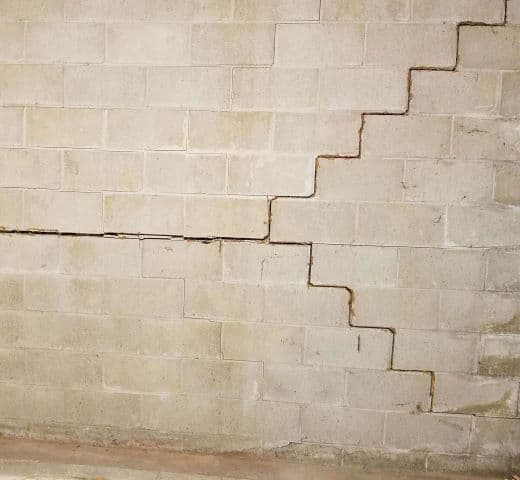
Originally posted 4/23/20, updated 10/8/21
You may not immediately realize that one of your basement walls is bowing. It’s usually a slow, gradual process that usually first displays as cracks in the wall. This is something you should watch for, and take action promptly if you notice any issues. We’re not recommending this just because we’re foundation experts that do these types of repairs.
A bowed wall is a critical concern- it threatens the structural integrity of your home. Your entire house is relying on the strength of your foundation. If a bowing wall is not repaired, it will eventually collapse. When a foundation wall collapses, your home suffers severe structural damage. Your home is now open to the elements- rain, mud, wind, and worse can freely intrude into your basement. And once the main floor of your home is no longer adequately supported, walls in the rest of your home will lean, floors will droop, pipes will strain and burst… essentially, your home will no longer be safe to live in and your foundation will need to be rebuilt. We’re not trying to use “scare tactics” to frighten you; we genuinely want to help you prevent this from happening to your home. We occasionally meet homeowners experiencing this type of situation, and we wouldn’t wish it on anyone!
Acculevel has been repairing foundations and restoring peace of mind since 1996. There are several different methods for repairing a cracked or bowed wall, depending on the situation. We will review each type and clearly explain the best circumstances for using them. This will allow you to evaluate each on its own merits, and determine what method is best for you and your home.
What Are Signs of a Bowing Wall?
We recommend that you check your home and foundation at least once a year, as a precautionary measure. If you would like details for this, we offer a DIY checklist for what to look for in another article.
For our purpose here, you are looking for a long horizontal crack in the wall. If the basement wall is made of concrete block, it may look like stair-step cracks instead. Below is a picture where you can see both.
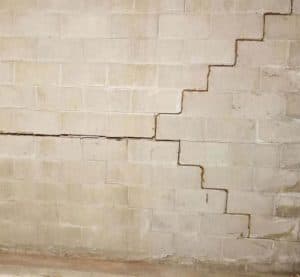 This picture was taken by an Acculevel project advisor during a routine free estimate appointment.
This picture was taken by an Acculevel project advisor during a routine free estimate appointment.
What Causes a Bowing Wall?
If you have a bowing wall, chances are it’s due to hydrostatic pressure. This pressure is caused when the ground around your home is saturated with water. When too much water accumulates, it starts to “push” or exert pressure against your foundation walls. We discuss hydrostatic pressure and its consequences more thoroughly in this article. In most cases, it’s taken several years for hydrostatic pressure to crack your basement wall.
In rare cases, hydrostatic pressure can cause significant bowing in just a few hours or days. This would be the result of severe weather events with high rain levels and ground saturation or flooding.
This means that water has been a problem on the outside of your home for a significant amount of time. If it hasn’t intruded into your basement, yet? You’ve been lucky, because that much water pressure usually seeps into -and through- concrete.
If you have been experiencing water intrusion, it’s entirely possible that you may need water drainage installed. Waterproofing will alleviate the pressure on your currently bowing wall, and can prevent hydrostatic pressure from damaging the other walls of your basement, later.
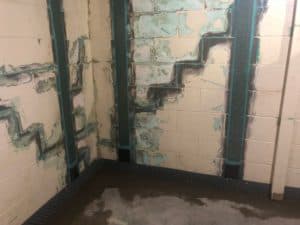
This photo was taken by an Acculevel team member after sealing cracks, installing carbon fiber straps on two adjoining walls, and interior water drainage around the basement perimeter. (FYI: Once dry, these repairs can be painted over.)
Our goal at Acculevel is to help you preserve and protect your home. We do this by providing a whole-home solution, which should address both your home’s current symptoms and the underlying cause of the issue.
What is The Best Method for Repairing a Bowed Wall?
I don’t mean to sound evasive, but the answer to this depends on how far the wall is bowing. The options for repair become more invasive and more expensive, as the damage increases. The earlier you take action, the better for your home and wallet!
The three types of repair are carbon fiber straps, wall anchors, and helical tiebacks. We’ll walk you through the details of each one. Based on how far your wall is bowing, one of these solutions will be the best option for your home.
I’d like to make a distinction, before we dive into the details. Repairing a bowed wall does not necessarily straighten it back to its original position. The purpose of these repairs is to stabilize and secure the wall. The goal is to fix the issue, provide strength to the wall, and restore stability to your foundation.
If a return to plumb (it’s original upright position) is what you want, this may require wall straightening. Wall straightening requires excavation outside the basement, A contractor then uses hydraulic jacks inside the basement to push the wall back into position. Once in its optimal place, the wall is then secured, usually with carbon fiber straps.
What Are Carbon Fiber Straps, and How Do They Work?
Typically, if your wall is bowing 2 inches or less, a contractor can install carbon fiber straps. This is the ideal option, because carbon fiber straps are the least invasive and least expensive option. The carbon straps that Acculevel uses are made of a kevlar material that, once properly secured, should restore your home’s structural stability. (Acculevel warranties their carbon fiber straps for the life of the structure.)
The straps are secured to the wall with epoxy. This epoxy seals the wall and fuses the strap to it. Straps should be placed approximately every 4 feet along the wall. This kind of installation can be done entirely from the inside of the basement, so no excavation is required.
The straps have a special anchor at the top and bottom of the wall, to prevent shearing or sliding. Once the installation is complete, the straps and wall can be painted to minimize the repair’s appearance.
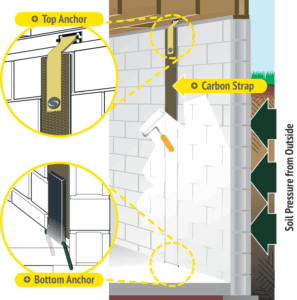 This is an illustration of Fortress Carbon Fiber Straps
This is an illustration of Fortress Carbon Fiber Straps
If your wall is bowing 2 inches or less, carbon straps are going to be the best solution for your home.
What Are Wall Anchors, and How Do They Work?
If your wall is bowing more than 2 inches, you have to consider steel wall anchors. Installation requires work both inside and outside of your basement. Anchors, when properly installed, should also restore your home’s stability and last for an extended period of time. (Acculevel warranties their anchor installations for the life of the structure.)
To install a wall anchor, the contractor needs at least 10 feet of usable and accessible ground outside the basement. This requires a certain amount of excavation, and how much impact this has will depend on what is outside the damaged wall. This can mean removing or relocating items like decking, porches, sidewalks, garages, etc.
A steel plate or channel is attached to your basement wall, then another plate is buried in the yard, and the two are connected by a steel shaft. As the steel rod is tightened, it exerts pull on the wall and the anchor in the yard holds it fast. Anchors should be placed about every 5 feet along the bowing wall.
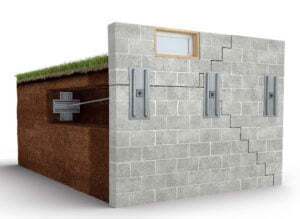 This is an illustration of Wall Anchors.
This is an illustration of Wall Anchors.
If your property is arranged in such a way that anchors are not a good (or legal) option, you’ll need to use tiebacks. A few examples of this would be:
- The excavation would require removing a home addition.
- There is an inground pool in that space.
- Installing the anchor would cross your property line into the neighbor’s yard or onto public land.
If your wall is bowing more than 2 inches and you have 10 feet of clear access around the affected area, wall anchors are the best solution for you.
What Are Helical Tiebacks, and How Do They Work?
Tiebacks are the most expensive option, but they are sometimes necessary. If your wall is bowing more than 2”, but your property arrangement doesn’t allow for anchors, helical tiebacks are the best option. Like the other two options, properly installed tiebacks should restore your home’s structural stability. (And Acculevel warranties their tiebacks for the life of the structure.)
A steel shaft with helical (screw-like) plates on the end is drilled at an angle through the earth outside of your foundation. This shaft is secured to the inside of the basement wall. This is done with a large steel channel that is anchored into the floor and extends up to (or near) the top of the wall.
At this point, the contractor twists the tieback to a specific torque that holds it firmly. Usually, tiebacks are 14-21 feet long, but in certain cases, longer lengths are required to get the proper “grip” or resistance on the soil.
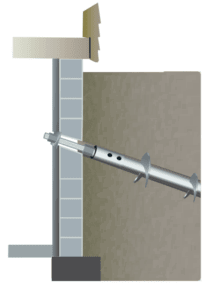 This is an illustration of a Helical Tieback.
This is an illustration of a Helical Tieback.
Again, if your wall is bowing too much for straps, but your property arrangement doesn’t allow for anchors, helical tiebacks are the best option.
If You See Signs of Bowing in Your Basement Wall, Take Action.
Please remember- the sooner you address this issue, the less it will cost you. Delays can be extremely costly, cause significant damage, and even become a safety concern in the event of a collapse.
You should find a contractor that is reputable, insured, and accredited with the BBB. If you are unsure about how to go about this, we have a detailed list of questions you should ask a contractor.
If you live in Indiana or the surrounding states, contact Acculevel. We have an A+ rating with the BBB, and will treat your home as if it is our own.
You can request a free estimate, and our friendly office staff will make an appointment with one of our local project managers. They will evaluate your foundation concerns and recommend the best course of action for you, to keep your home strong and healthy for years to come.
